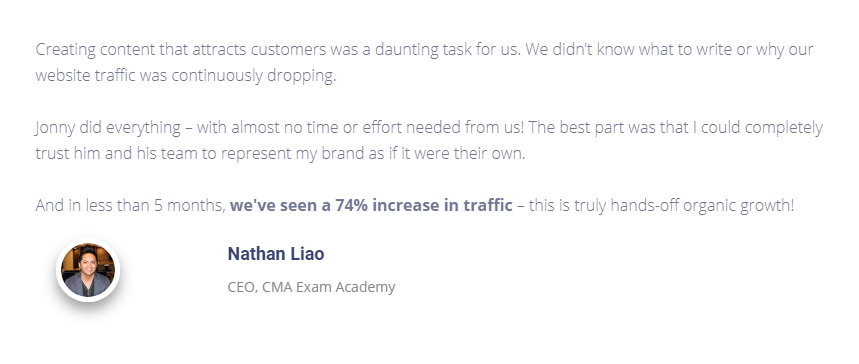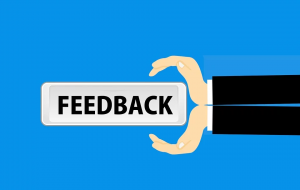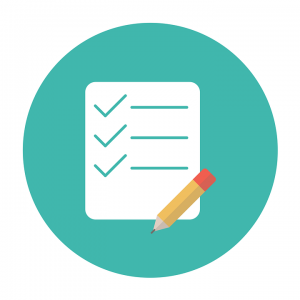
Including testimonials on your website is one of the best ways to increase conversions.
Don’t believe me?
One survey found that 99.5% of Americans research purchases sometimes before they commit to a business or product. 77% of shoppers specifically seek out websites with ratings and reviews. If you don’t have any, they might just take their money elsewhere.
While testimonials and reviews aren’t exactly the same, they serve a similar function: social proof.
Let’s face it, you’re going to rave about your own business no matter what. Confidence is part of the entrepreneurial mindset. But without credible evidence, why should potential customers believe you?
When you back up your claims with real feedback from real people, in the form of testimonials, there’s no reason to doubt.
You instantly establish credibility and trust, by showing that others have had a great experience.
We’re here to talk about how to get customer feedback and use it to write a testimonial that will do the selling for you.
Originally published on November, 13th, 2019, this article was updated and republished on July 15th, 2024.
What Is a Testimonial?

Testimonials are written statements of recommendation.
They allow satisfied customers to speak to the quality of your service or products — and this is the critical difference between a testimonial and a review.
Testimonials are positive endorsements that typically come at your request. Reviews can be left by any customer (and some may be negative). Unfortunately, studies have found that readers tend to put a lot of weight on negative reviews.
Testimonials are your chance to counteract that negativity.
What Is the Goal of a Testimonial?
Testimonials are a must-have in your brand’s marketing arsenal.
The goal of featuring testimonials in your marketing is to draw:
- Strengthen credibility: Deloitte research shows that 81% of consumers read reviews before buying products and services. And they see these reviews as more trustworthy than other information sources. That means testimonials are crucial to building your brand’s reputation.
- Boost sales: Forbes found that 58% of customers will pay more for a product or service with good reviews. This shows it pays to accrue positive reviews–not just in terms of reputation, but in direct sales.
- Enhance brand awareness: The more people talk about your brand positively online, the more likely it is to get seen by potential prospects. Over time, this can make your brand recognizable and trusted in your respective market.
- Turbocharge the customer experience: Reviews aren’t just for potential customers to assess your business. You should watch them too. When you get a negative review, listen to your customers’ feedback, and use it to spot patterns. When you get positive reviews and testimonials, you can further develop products, features, and services based on what your customers love.
How to Get a Testimonial From Your Customers
When first starting, asking for testimonials will be your best bet. Reach out to customers (especially repeat customers), and ask if they’ll give you positive feedback that you can use on your website.
If you have clients that run their own business, allow them to link back to their website in their testimonial if it’s relevant. That way, their testimonial is mutually beneficial (links are an important factor that can help you get to the first page of Google).
How you collect testimonials is up to you. You can either use email, Google Forms, request a video, or ask them to leave a review on Google or a review website.
Whatever you do, putting together a few questions to guide your customers toward the answers you want is helpful. Things like:
- What was it like before you used our product or service?
- How did you find out about our company?
- What other competitors did you consider, and what made you choose us?
- How has our product helped you?
- What’s the main reason you would recommend our brand to others?
As you build your business, pay attention to any unprompted positive feedback. If a customer writes thanking you for your service or posts about their satisfaction on social media, respond with gratitude.
Ask if they’d be comfortable if you used their words in a testimonial on your website.
You can also set up an automated process to ask your customers about their experience.
Don’t forget the importance of incentives, either! To entice customers into sharing testimonials, you can offer rewards like a percentage off their next purchase or the chance to win a gift.
How to Write a Testimonial

Should you leave the content up to the customer writing the testimonial?
No! That’s a wasted opportunity.
What you’ll most likely receive is a generic, positive statement that won’t help your conversions.
You need specific, relevant details to include in your testimonials, to give them weight and credibility.
As you gather testimonials, determine a format that you’ll follow each time. You may give the writer a template to use or plug their feedback into a template, yourself.
As long as you’re not adding your own opinions, under the guise that someone else wrote it, there’s nothing wrong with using a template. In fact, telling people specifically what you want to know makes it much easier for them to write — no blank page anxiety.
We’re going to break down proper testimonial writing into a few categories before offering tips, examples, and a template you can try out for yourself.
Testimonial Format: 5 Essential Parts of a Winning Testimonial

Some testimonials consist of short quotes that are one or two sentences long. These aren’t bad, but they leave out some important persuasive elements.
It’s much more effective to include specific information about the benefits of your business.
Here are the essential pieces of a winning testimonial:
1. The Attention-Grabbing Opener
Start with something positive and attention-grabbing before breaking down the specifics.
That might be something like, “This product was a huge help to me!”
That way, even readers who skim for information will know that your customers are happy with your business.
2. Establish the Problem
The next ingredient is a description of the problem your business solved for this customer. What issue were they having that prompted them to work with your business?
If the testimonial is offered by someone who isn’t a customer, but a colleague or expert, establish their authority here. Why should potential customers listen?
3. Describe Some Hesitation
Next, explain any initial hesitation the customer had. Were they concerned with the price of your service? Have they worked with similar businesses in the past that didn’t deliver good results?
It may seem strange to ask your customers to discuss their hesitation when considering your business. Why would you want your readers to think about the drawbacks they may not already be considering?
However, noting those drawbacks reveals a level of honesty and authenticity that will give readers more reason to trust your testimonial.
4. The Outcome
Finally, demonstrate the usefulness of your service. How did your business help the customer overcome the problem they were having?
When you transition from drawbacks to usefulness, readers will understand that your product or service is worth the cost, the effort, or whatever else may have deterred them.
5. The Recommendation
The final piece ties it all together. Will they use your business again and have they recommended your services to anyone else?
By now, readers have already read about how your product or service solved this customer’s issue. And they’ve thought about reasons they might hesitate to buy.
This final endorsement reassures people that they can let go of those worries — like this satisfied customer, they will have no regrets.
How Long Should a Testimonial Be?
That’s a lot of information to pack into one testimonial, and it needs to be concise.
In the golden age of the internet, studies have found that our attention spans are getting shorter. In fact, we’re likely to lose interest in what we’re viewing online in less than ten seconds.
Ideally, each component of the testimonial format will be taken care of in one or two sentences each. Don’t overwhelm your readers with a huge block of text, but don’t underwhelm them with one sentence.
Try to stay under 500 words and break up blocks of text by using a few short paragraphs.
What Makes a Powerful Testimonial?
Just gathering a few endorsements isn’t enough to really pack a punch with your testimonials. Read on for a few tips and tricks on how to make a truly powerful testimonial.
Placement: Don’t Hide Your Testimonials

Some businesses make a separate page on their website for testimonials, but we aren’t crazy about this method – you shouldn’t make your readers hunt for positive feedback on your products or services.
When you’re writing a sales page, include testimonials for the product. If it’s a new product, and you don’t have any feedback yet, you can use a more general testimonial for your business.
For example, say you are selling an online course on jewelry making and an online course on candle making. If you receive an endorsement for your jewelry course, use it for a testimonial on the sales page, and any email marketing campaigns you send.
Then you can repurpose it for the candle-making course sales page. Just pick out the parts that talk about your teaching style or course format — things that can apply to your business in general.
Don’t hide testimonials somewhere on another page, because that’s not nearly as helpful or relevant.
Relevance: Don’t Waste Space with Irrelevant Information
Every word counts. Don’t waste space and time with information that doesn’t strengthen the testimonial.
We mentioned earlier that testimonials should provide some information about who the writer is, and why that lends them some authority on your business. This only applies if they are an expert in your field.
For example, if a professional fisherman purchases your fishing line and loves it, it’s relevant for them to mention their profession. However, it is not relevant that they are a fisherman if they purchased your beginner yoga course.
Experiment: Try Different Media Formats
You will probably see written testimonials more than anything else. That being said, why not experiment with different formats to see what gets the best results?
If other formats make sense for your business, try them out. For example, we run a business podcast and could use that forum for audio testimonials.
If your product or service is best explained visually, you may want to try using video testimonials where customers can show your product or service in action.
Testimonial Examples

To give you a better sense of what good testimonials look like, we’ve put together a few examples. Let’s take a look at a strong customer testimonial as well as a strong partner testimonial.
Customer Testimonial


Above, I’ve included some examples of fantastic customer testimonials that my team gathered at my SEO agency, Digital Commerce Partners.
Partner testimonial

For this example, let’s use a hypothetical. Let’s say that the testimonial comes from a real estate investor who has partnered with an online real estate marketer.
“Running my properties has gone much more smoothly since partnering with Apartments R Us. I have owned two large apartment buildings in Florida for thirty years and I didn’t know how to start marketing my buildings online.
Not only did they help me fill all of my apartments after a particularly high turnover rate last summer, but they’ve saved me a ton of time screening them. I never could have done it without them, and will continue to partner with them for the rest of my time in real estate.”
James M, Real Estate Owner.
Testimonial Template (And Questions to Ask Your Customers)

Before you can put the customer feedback into the form of a testimonial, you need to get the right information. Start by asking your customers a series of questions.
For a video or audio testimonial, you can even ask them to use these questions as prompts when deciding what to say.
Here are the questions to start with:
- What issue did you need to solve?
- What drew you to our business?
- Did you have any concerns going in?
Then follow up with these:
- How did we solve your problem?
- Why would you recommend us to other people?
- Is there anything about our model that really stood out to you?
While your testimonials shouldn’t all be cookie-cutter replicas of one another, you can use the same basic statements to structure the answers you get.
Here’s a 5-point testimonial template to pull it all together:
- I am in the business of…
- I looked into [business] because…
- [Business] helped me with…
- The results were that…
- Overall, I am very pleased with…
FAQ
Here are a few commonly asked questions about writing testimonials.
How to start a testimonial letter?
Winning testimonial letters take the form of a compelling story. They start with an attention-grabbing opener before moving on to exploring a problem the customer had.
You should then explain why the customer chose your product and how it helped them overcome their pain points.
How long should a testimonial be?
The best testimonials are under 500 words, with plenty of paragraphs to improve readability.
What makes a testimonial stand out?
Great testimonials start with a bang: an attention-grabbing, personal opening that hooks the reader in.
Better Your Business with Testimonials
Now that you’ve learned how to write a testimonial that will draw in new customers and build your reputation, reach out and ask your customers to vouch for you!
Once your website is set up to win over potential customers, it’s time to start building traffic. My team at Digital Commerce Partners can help. So if you want to step up your online presence and grow your organic search traffic, get in touch today.